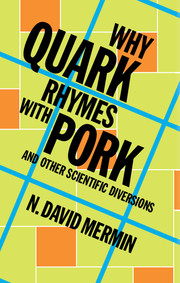Book contents
- Frontmatter
- Dedication
- Contents
- Preface
- Part One Reference Frame Columns, Physics Today 1988–2009
- Part Two Shedding Bad Habits
- Part Three More from Professor Mozart
- Part Four More to be Said
- Part Five Some People I've Known
- 39 My life with Fisher, lecture, Rutgers University, 2001
- 40 My life with Kohn, 2003, updated 2013
- 41 My Life with Wilson, lecture, Cornell University, 2014
- 42 My life with Peierls, unpublished lecture, Santa Barbara, 1997
- Part Six Summing it Up
- Index
41 - My Life with Wilson, lecture, Cornell University, 2014
from Part Five - Some People I've Known
Published online by Cambridge University Press: 05 January 2016
- Frontmatter
- Dedication
- Contents
- Preface
- Part One Reference Frame Columns, Physics Today 1988–2009
- Part Two Shedding Bad Habits
- Part Three More from Professor Mozart
- Part Four More to be Said
- Part Five Some People I've Known
- 39 My life with Fisher, lecture, Rutgers University, 2001
- 40 My life with Kohn, 2003, updated 2013
- 41 My Life with Wilson, lecture, Cornell University, 2014
- 42 My life with Peierls, unpublished lecture, Santa Barbara, 1997
- Part Six Summing it Up
- Index
Summary
I met Ken Wilson in 1952, when I was 17 and he was 16. We were both freshmen in the Harvard class of 1956, which produced an exceptionally large number of well-known physicists. As I remember Ken and I were in the same introductory German class, but it might have been the required freshman composition course, which met in the same building. What I remember for sure is that I got an A and Ken got a B. This was the only time in my life that I understood something better than he did.
What I remember most about Ken from 1952 is that although he was 16, he looked about 13. I don't think he looked 16 until he got tenure at Cornell. An important part of his youthful look was that when somebody said something that really pleased him, his face would light up with such a sweet smile that it warmed your heart, like the first smiles of a baby.
Indeed, there was a performance at the 1964 Cornell Physics Department Christmas party, the year I got here, in which graduate students sang satirical songs about their Professors. What they sang about Ken was based on a song from South Pacific (“Bloody Mary is the one I love, now ain't that too damn bad!”) It went “Kenny Wilson is the cutest Prof, but mesons ain't much fun.” Mesons may indeed not have been much fun, but within ten years Ken was to provide theoretical physicists with the best opportunities for fun that they had since the invention of quantum mechanics.
Ken and I were math majors at Harvard. He had a formidable reputation as a mathematician and was at least two years ahead of me in the math curriculum. It being Harvard, however, by general agreement, which I believe Ken subscribed to, he was only the second-best mathematician in our class. I found this abundance of superior talent discouraging. To escape from mathematicians who were too smart to compete with, I stayed at Harvard for graduate school, but switched to physics. Out of the frying pan into the fire.
In 1959 Ken reappeared in Cambridge as a Junior Fellow. Much to my surprise, he too had become a physicist, irritatingly fast, at CalTech.
- Type
- Chapter
- Information
- Why Quark Rhymes with PorkAnd Other Scientific Diversions, pp. 341 - 345Publisher: Cambridge University PressPrint publication year: 2016



